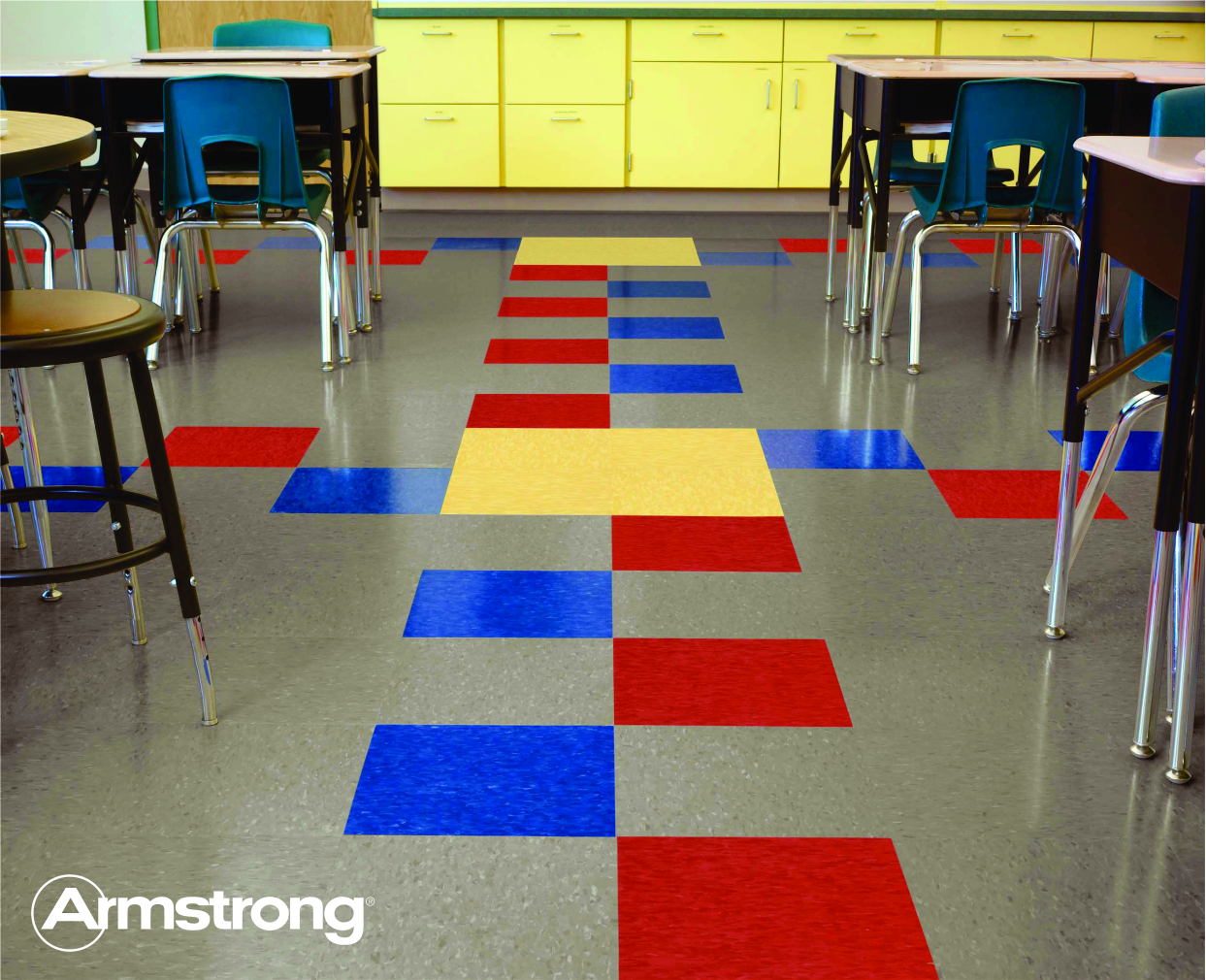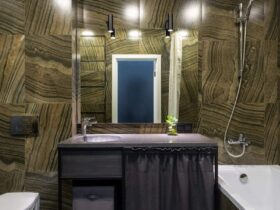School floor tiles are typically made of materials such as vinyl, rubber, linoleum, or carpet. These materials are chosen for their durability, easy maintenance, and ability to withstand heavy foot traffic.
Vinyl tiles are popular due to their cost-effectiveness and wide range of designs, while rubber tiles offer impact resistance and noise reduction. Linoleum tiles are known for their eco-friendly composition, and carpet tiles provide warmth and comfort. The choice of material depends on factors such as budget, aesthetic preferences, and the specific requirements of the school environment.
When selecting floor tiles for schools, it’s essential to consider factors such as durability, maintenance, and safety. The material composition of the tiles plays a crucial role in meeting these requirements. Understanding the different types of materials used in school floor tiles can help in making informed decisions to create a conducive and functional learning environment.

Credit: www.continentalflooring.com
Introduction To School Flooring Requirements
Choosing the right flooring for schools is a crucial decision that impacts the safety, durability, and maintenance of the facility. School floors need to withstand heavy foot traffic, spills, and daily wear and tear, while also providing a safe and comfortable environment for students and staff. In this article, we will explore the key requirements for school flooring, focusing on the importance of durability, safety, and maintenance considerations.
The Importance Of Durability
Durable flooring is essential in school settings to withstand the constant activity and heavy use. With numerous students and staff walking, running, and engaging in various activities, school floors must be able to handle the daily wear and tear without showing signs of deterioration. Additionally, durable flooring minimizes the need for frequent repairs or replacements, saving both time and money for educational institutions.
Safety And Maintenance Considerations
Ensuring the safety of students and staff is paramount in school environments. The flooring material should offer slip resistance to prevent accidents and injuries, especially in areas prone to spills or high moisture content. Additionally, easy maintenance is crucial to keep the floors clean and hygienic. A flooring material that is resistant to stains, scratches, and dents makes cleaning and maintenance tasks more efficient, allowing custodial staff to focus on other essential duties.
Types Of Floor Tiles Used In Schools
School floor tiles are typically made of durable materials like vinyl, rubber, or linoleum. These materials are chosen for their longevity and easy maintenance, making them ideal for high-traffic areas like schools. The tiles are designed to withstand daily wear and tear while providing a safe and clean environment for students.
Types of Floor Tiles Used in Schools
Flooring is an essential aspect of any school building, as it not only enhances the overall aesthetic appeal but also plays a vital role in ensuring the safety and comfort of students and staff. When it comes to school flooring, there are various types of floor tiles used, including Vinyl Composite Tiles (VCT), Ceramic, and Porcelain Tiles. Let’s take a closer look at each of these types of floor tiles used in schools.
Vinyl Composite Tiles (VCT)
One of the most popular types of floor tiles used in schools is Vinyl Composite Tiles (VCT). These tiles are made of a combination of natural limestone, filler materials, thermoplastic binder, and color pigments. VCT tiles are highly durable, easy to install, and require low maintenance. They are also slip-resistant, making them an ideal choice for high-traffic areas such as school hallways, classrooms, and cafeterias.
Ceramic and Porcelain Tiles
Ceramic and Porcelain Tiles are another popular choice for school flooring. These tiles are made of clay, sand, and natural minerals that are fired at high temperatures to create a hard, durable surface. Ceramic tiles are usually less expensive than porcelain tiles but are more porous, making them less suitable for areas that are prone to spills and moisture. Porcelain tiles, on the other hand, are denser and less porous, making them an ideal choice for high-moisture areas such as bathrooms and locker rooms.
In conclusion, choosing the right type of floor tile for a school building is crucial to ensure safety, durability, and comfort. Whether it’s Vinyl Composite Tiles (VCT), Ceramic, or Porcelain Tiles, each of these types of floor tiles has its unique benefits and drawbacks. By understanding the characteristics of each type of tile, school administrators can make an informed decision on which type of tile is best suited for their school’s needs.
Material Composition And Properties
School floor tiles are typically made of durable materials like ceramic, vinyl, or linoleum. These materials offer a mix of strength, easy maintenance, and design versatility to withstand heavy foot traffic in educational settings. The composition and properties of these tiles ensure long-lasting functionality and aesthetic appeal.
Ingredients Of Vinyl Tiles
Vinyl tiles, commonly used in school flooring, are composed of several key ingredients that contribute to their durability and versatility. The primary component is polyvinyl chloride (PVC), a synthetic plastic polymer known for its strength and resilience. This PVC base is blended with plasticizers to enhance flexibility and stability. Furthermore, fillers such as limestone, clay, and silica are added to improve the tiles’ strength and resistance to wear and tear. Pigments are also incorporated to provide various color options and designs.
Characteristics Of Ceramic Materials
Ceramic tiles, another popular choice for school floors, are made from a mixture of clay, minerals, and water. This composition undergoes a firing process to create a dense and durable material. The key characteristics of ceramic tiles include:
- Hardness: Ceramic tiles are known for their hardness, making them resistant to scratches and dents.
- Water Resistance: Due to their low water absorption rate, ceramic tiles are highly resistant to moisture, making them suitable for areas prone to spills or high humidity.
- Stain Resistance: The non-porous surface of ceramic tiles prevents staining, making them easy to clean and maintain.
- Heat Resistance: Ceramic tiles can withstand high temperatures without warping or melting, making them ideal for areas with heat sources.
- Chemical Resistance: Ceramic tiles are resistant to chemicals, making them suitable for laboratories and areas where chemical spills may occur.
- Design Options: Ceramic tiles come in a wide range of colors, patterns, and textures, allowing for customization to match the aesthetic preferences of schools.
In conclusion, both vinyl and ceramic tiles offer unique advantages in terms of material composition and properties. Vinyl tiles are known for their flexibility, durability, and color options, while ceramic tiles offer hardness, water resistance, heat resistance, and design versatility. The choice between the two ultimately depends on the specific requirements and preferences of the school.
Comparing Durability And Lifespan
When it comes to choosing the right flooring for schools, durability and lifespan are crucial factors to consider. Understanding the materials and comparing their wear and tear resistance and longevity can help make an informed decision.
Wear And Tear Resistance
The wear and tear resistance of school floor tiles is a critical consideration, as they must withstand heavy foot traffic, spills, and potential damage from desks and chairs. Vinyl and rubber tiles are known for their high resistance to wear and tear, making them ideal choices for school environments. On the other hand, linoleum and ceramic tiles also offer good durability but may not be as resistant to impact and heavy usage.
Longevity Of Different Tile Types
When it comes to the longevity of school floor tiles, ceramic and linoleum tiles are known for their durability and can last for decades with proper maintenance. Vinyl and rubber tiles, while highly resistant to wear and tear, may have a slightly shorter lifespan but still offer excellent longevity when well-maintained.
Environmental And Health Impact
The environmental and health impact of school floor tiles is a crucial aspect to consider when choosing flooring materials. Understanding the composition of these tiles and their effects on the environment and indoor air quality is essential for creating a safe and sustainable learning environment.
Eco-friendly Flooring Options
When selecting school floor tiles, exploring eco-friendly options can significantly reduce the environmental impact. Sustainable materials such as cork, bamboo, and recycled content tiles offer a more environmentally responsible choice for educational facilities.
Indoor Air Quality And Tile Materials
The materials used in school floor tiles directly impact indoor air quality. Opting for low-VOC (volatile organic compound) and formaldehyde-free tiles is crucial to ensure a healthy indoor environment for students and staff.
Installation And Maintenance Insights
When it comes to school floor tiles, proper installation and regular maintenance are crucial to ensure their longevity and functionality. By following best practices for tile installation and implementing routine and long-term maintenance tips, schools can keep their floors in top condition, providing a safe and attractive environment for students and staff.
Best Practices For Tile Installation
Installing school floor tiles requires attention to detail and adherence to specific guidelines. Here are some best practices to consider:
- Prepare the subfloor properly by ensuring it is clean, dry, and level.
- Use the right adhesive recommended by the tile manufacturer, considering factors such as the type of tile and the subfloor material.
- Follow the manufacturer’s instructions for mixing and applying the adhesive.
- Ensure proper tile spacing to allow for expansion and contraction.
- Use a level and straight edge to ensure the tiles are laid evenly and aligned correctly.
- Allow sufficient time for the adhesive to dry and cure before allowing foot traffic on the floor.
Routine And Long-term Maintenance Tips
Regular maintenance is essential for keeping school floor tiles clean and in good condition. Here are some tips for routine and long-term maintenance:
- Sweep or vacuum the floor regularly to remove dirt and debris.
- Wipe up spills immediately to prevent stains and damage.
- Use mild cleaning solutions and avoid harsh chemicals that can damage the tiles.
- Follow the manufacturer’s guidelines for specific cleaning products.
- Consider using mats or rugs in high-traffic areas to reduce wear and tear.
- Periodically inspect the tiles for any cracks, chips, or loose tiles, and repair or replace them as needed.
By following these installation and maintenance insights, schools can ensure the durability and longevity of their floor tiles, providing a safe and aesthetically pleasing environment for students and staff.
Frequently Asked Questions
What Materials Are School Floor Tiles Made Of?
School floor tiles are commonly made of vinyl, rubber, linoleum, or carpet materials.
Are School Floor Tiles Easy To Clean?
Yes, school floor tiles are designed for easy maintenance and can be cleaned effortlessly.
Do School Floor Tiles Come In Various Designs?
School floor tiles come in a wide range of designs, colors, patterns, and textures.
Are School Floor Tiles Durable And Long-lasting?
School floor tiles are durable, resilient, and built to withstand heavy foot traffic.
Can School Floor Tiles Help In Sound Insulation?
Yes, school floor tiles can help reduce noise levels and provide sound insulation benefits.
Are School Floor Tiles Eco-friendly And Sustainable?
Many school floor tiles are eco-friendly, recyclable, and made from sustainable materials.
Conclusion
School floor tiles are made of various materials such as vinyl, rubber, carpet, and ceramic. These materials are chosen based on their durability, safety, and ease of maintenance. It is important to consider these factors when selecting the right flooring for educational facilities.
Proper installation and maintenance of school floor tiles can enhance the learning environment and ensure the safety of students and staff. By understanding the materials used, educational institutions can make informed decisions about their flooring needs.









Leave a Reply